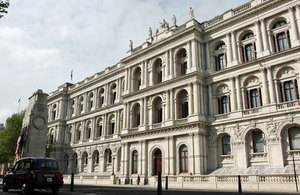Legislation creating the powers for the UK to operate as an independent coastal state and manage its fish stocks sustainably outside the EU is being introduced into Parliament today (29th January 2020).
The introduction of the Fisheries Bill delivers a legal guarantee the UK will leave the Common Fisheries Policy (CFP) at the end of the Transition Period, in December 2020 – allowing the UK to control who may fish in our waters, and on what terms, for the first time since 1973.
The Bill ends current automatic rights for EU vessels to fish in British waters. In future, access to fish in UK waters will be a matter for the UK to negotiate and we will decide on the rules that foreign vessels must follow.
As well as powers to implement new deals negotiated with the EU and other coastal states, set quotas, fishing opportunities and days at sea, the Bill includes new measures for Devolved Governments and a single set of UK-wide fisheries objectives to ensure that fish stocks, and the marine environment, are better protected.
Changes to funding rules enabling the UK government to provide financial support for the breadth of what is currently funded by the EU’s European Maritime and Fisheries Fund, such as training and port improvements, are also included in the legislation.
Environment Secretary Theresa Villiers said:
This new Fisheries Bill takes back control of our waters, enabling the UK to create a sustainable, profitable fishing industry for our coastal communities, whilst securing the long term health of British fisheries.
Leaving the EU’s failed Common Fisheries Policy is one of the most important benefits of Brexit. It means we can create a fairer system which will allow marine habitats to thrive, with new powers to support our fishing sector and conserve our wonderful Blue Belt at home and abroad.
Fisheries Minister George Eustice said:
The Fisheries Bill gives us the powers to implement our own independent fisheries policy, improve our marine habitats and make decisions based on the health of our fish stocks not vested interests.
For many people in coastal communities, taking back control and leaving the Common Fisheries Policy is at the heart of getting Brexit done, and this Bill delivers for the environment, fishermen and the Union.
Barrie Deas, Chief Executive of the National Federation of Fishermen’s Organisations, said:
The central purpose of the Bill is to give UK Ministers powers to manage UK fisheries after we leave the Common Fisheries Policy. We very much welcome that.
New provisions in the Bill mean the UK will take into account climate change impacts on its fisheries, with a new objective to move us towards ‘climate-smart fishing’ in UK waters. Last year we became the first major economy in the world to pass laws to end our contribution to global warming by 2050 and the Fisheries Bill will complement this.
A new legal requirement for all fish stocks to be fished at sustainable levels is also at the heart of the Bill – delivering on the government’s manifesto commitment to ensure there will be sustainability plans for each fish stock.
The Bill includes powers to ensure fisheries management decisions are taken strategically, for the benefit of the whole marine environment. Fisheries management plans will be will be tailored to the UK’s ‘mixed fisheries’, which have lots of fish stocks swimming together and where certain fishing practices can have a significant impact on the marine environment.
The plans will also recognise that many of our fish stocks are ‘shared stocks’ as they will swim in both the UK’s and other coastal states’ waters. For these stocks, negotiation with other coastal states is crucial as sustainable catches cannot be achieved through UK action alone.
The Bill also boosts the government’s flagship Blue Belt programme by ensuring the Marine Management Organisation has the powers it needs to provide advice and assistance on sustainable fisheries, marine planning, licensing and conservation overseas.
The Bill’s provisions on sustainable fishing will be underpinned by the requirement for the UK government and the Devolved Administrations to publish a Joint Fisheries Statement to coordinate fisheries management where appropriate, and Fisheries Management plans to achieve sustainable stocks.
The Bill will also ensure:
- EU vessels’ automatic access right to fish in UK waters is removed
- Foreign boats will be required to be licensed to fish in UK waters and will have to follow the UK’s rules
- Fisheries are managed in a sustainable way – balancing social, economic, and employment benefits while preventing the over exploitation of fish stocks
- The UK fisheries administrations will seek to ensure increased benefits from fish caught by UK boats
- Sensitive marine species, such as dolphins, are protected and the bycatch of unwanted fish reduced
- The UK fisheries administrations will continue to collect robust scientific data on fish stocks and shares it to manage shared stocks sustainably
- UK boats can continue to access any part of UK waters, as they do now regardless, whether they are registered in England, Scotland, Wales or Northern Ireland
